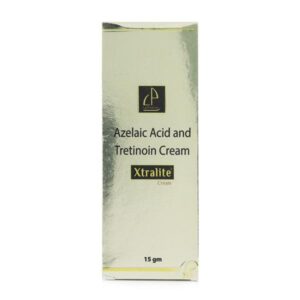AZELAIC ACID + TRETIROIN
Azelaic Acid: Azelaic Acid is a topical medication used to treat mild to moderate acne and rosacea. It is available in the form of a gel, cream, or foam and is applied directly to the affected areas of the skin.
The exact mechanism of action of Azelaic Acid is not fully understood, but it is believed to work by reducing inflammation and killing the bacteria that contribute to acne. It also helps to normalize the growth of skin cells, preventing clogged pores.
The recommended dose of Azelaic Acid varies depending on the formulation and the condition being treated. For acne, it is typically applied twice daily, while for rosacea, it may be applied once or twice daily. It is important to follow the instructions provided by the healthcare professional or as indicated on the product label.
Common side effects of Azelaic Acid include skin irritation, redness, itching, and burning. These side effects are usually mild and temporary. In some cases, the skin may become more sensitive to sunlight and prone to sunburn. It is important to use sunscreen and protective clothing while using Azelaic Acid.
Less common side effects may include dryness, peeling, and changes in skin color. If any severe or persistent side effects occur, it is advisable to contact a healthcare professional.
Azelaic Acid may interact with other topical medications, so it is important to inform your healthcare provider of any other treatments you are using. It is also important to avoid using Azelaic Acid on broken or irritated skin.
Overall, Azelaic Acid is an effective topical treatment for acne and rosacea. However, it is always best to consult with a healthcare professional before starting any new medication to ensure it is suitable for your individual needs.
Tretiroin: Tretinoin is a medication commonly used in the treatment of acne and certain skin conditions. It is a derivative of vitamin A and belongs to a class of drugs called retinoids. Tretinoin is available in various forms, including creams, gels, and solutions.
The exact mechanism of action of tretinoin in treating acne is not fully understood. However, it is believed to work by decreasing the formation of acne lesions and promoting the turnover of skin cells. Tretinoin helps to normalize the skin cell growth cycle, resulting in reduced formation of comedones (clogged pores) and inflammation associated with acne.
The recommended dose of tretinoin varies depending on the form of the medication and the condition being treated. Generally, for acne, a thin layer of tretinoin cream or gel is applied to the affected area once daily, preferably at bedtime. It is important to follow the instructions provided by the healthcare provider or the product label.
Like any medication, tretinoin can cause side effects. Some common side effects include redness, dryness, peeling, itching, and skin irritation at the application site. These side effects are usually mild and temporary, and they tend to improve as the body adjusts to the medication. It is important to avoid excessive sun exposure and use sunscreen while using tretinoin, as it can increase skin sensitivity to sunlight.
Less common but potentially serious side effects of tretinoin may include severe skin irritation or allergic reactions. If any uncommon or severe side effects occur, it is advisable to consult a healthcare provider immediately.
Tretinoin is a prescription medication, and it is important to consult a healthcare provider before starting or discontinuing the use of this medication. They can provide more specific information about the appropriate use, dose, and potential side effects based on individual circumstances.

